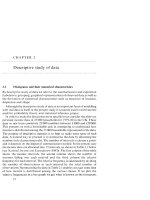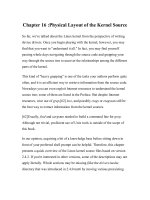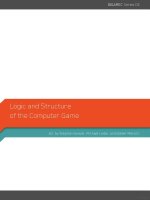Chapter 2: Instructions: Language of the Computer potx
Bạn đang xem bản rút gọn của tài liệu. Xem và tải ngay bản đầy đủ của tài liệu tại đây (1.15 MB, 96 trang )
BK
TP.HCM
2009
dce
KIẾN TRÚC MÁY TÍNH
CS2009
Khoa Khoa học và Kỹ thuật Máy tính
BM Kỹ thuật Máy tính
Võ Tấn Phương
/>2009
dce
Chapter 2
Adapted from Computer Organization and
Design, 4
th
Edition, Patterson & Hennessy, ©
2008
©2009, CE Department
2
9/22/2009
Instructions: Language of the
Computer
2009
dce
The Five classic Components of a Computer
©2009, CE Department
3
9/22/2009
2009
dce
The Instruction Set Architecture
Chapter 2 — Instructions: Language of the Computer — 4©2009, CE Department
9/22/2009
2009
dce
A Overview of Assembler’s result
©2009, CE Department
5
9/22/2009
clear1(int array[], int size) {
int i;
for (i = 0; i < size; i += 1)
array[i] = 0;
}
clear2(int *array, int size) {
int *p;
for (p = &array[0]; p < &array[size];
p = p + 1)
*p = 0;
}
move $t0,$zero # i = 0
loop1: sll $t1,$t0,2 # $t1 = i * 4
add $t2,$a0,$t1 # $t2 =
# &array[i]
sw $zero, 0($t2) # array[i] = 0
addi $t0,$t0,1 # i = i + 1
slt $t3,$t0,$a1 # $t3 =
# (i < size)
bne $t3,$zero,loop1 # if (…)
# goto loop1
move $t0,$a0 # p = & array[0]
sll $t1,$a1,2 # $t1 = size * 4
add $t2,$a0,$t1 # $t2 =
# &array[size]
loop2: sw $zero,0($t0) # Memory[p] = 0
addi $t0,$t0,4 # p = p + 4
slt $t3,$t0,$t2 # $t3 =
#(p<&array[size])
bne $t3,$zero,loop2 # if (…)
# goto loop2
2009
dce
Instruction Set
• The repertoire of instructions of a
computer
• Different computers have different
instruction sets
– But with many aspects in common
• Early computers had very simple
instruction sets
– Simplified implementation
• Many modern computers also have simple
instruction sets
Chapter 2 — Instructions: Language of the Computer — 6©2009, CE Department
9/22/2009
2009
dce
Arithmetic Operations
• Add and subtract, three operands
– Two sources and one destination
add a, b, c # a gets b + c
• All arithmetic operations have this form
• Design Principle 1: Simplicity favours
regularity
– Regularity makes implementation simpler
– Simplicity enables higher performance at
lower cost
Chapter 2 — Instructions: Language of the Computer — 7©2009, CE Department
9/22/2009
2009
dce
Arithmetic Example
• C code:
f = (g + h) - (i + j);
• Compiled MIPS code:
add t0, g, h # temp t0 = g + h
add t1, i, j # temp t1 = i + j
sub f, t0, t1 # f = t0 - t1
Chapter 2 — Instructions: Language of the Computer — 8©2009, CE Department
9/22/2009
2009
dce
Register Operands
• Arithmetic instructions use register
operands
• MIPS has a 32 × 32-bit register file
– Use for frequently accessed data
– Numbered 0 to 31
– 32-bit data called a “word”
• Assembler names
– $t0, $t1, …, $t9 for temporary values
– $s0, $s1, …, $s7 for saved variables
• Design Principle 2: Smaller is faster
– c.f. main memory: millions of locations
Chapter 2 — Instructions: Language of the Computer — 9©2009, CE Department
9/22/2009
2009
dce
Register Usage
• $a0 – $a3: arguments (reg’s 4 – 7)
• $v0, $v1: result values (reg’s 2 and 3)
• $t0 – $t9: temporaries
– Can be overwritten by callee
• $s0 – $s7: saved
– Must be saved/restored by callee
• $gp: global pointer for static data (reg 28)
• $sp: stack pointer (reg 29)
• $fp: frame pointer (reg 30)
• $ra: return address (reg 31)
Chapter 2 — Instructions: Language of the Computer — 10©2009, CE Department
9/22/2009
2009
dce
Register Operand Example
• C code:
f = (g + h) - (i + j);
– f, …, j in $s0, …, $s4
• Compiled MIPS code:
add $t0, $s1, $s2
add $t1, $s3, $s4
sub $s0, $t0, $t1
Chapter 2 — Instructions: Language of the Computer — 11©2009, CE Department
9/22/2009
2009
dce
Memory Operands
• Main memory used for composite data
– Arrays, structures, dynamic data
• To apply arithmetic operations
– Load values from memory into registers
– Store result from register to memory
• Memory is byte addressed
– Each address identifies an 8-bit byte
• Words are aligned in memory
– Address must be a multiple of 4
• MIPS is Big Endian
– Most-significant byte at least address of a word
– c.f. Little Endian: least-significant byte at least
address
Chapter 2 — Instructions: Language of the Computer — 12©2009, CE Department
9/22/2009
2009
dce
Memory Operand Example 1
• C code:
g = h + A[8];
– g in $s1, h in $s2, base address of A in $s3
• Compiled MIPS code:
– Index 8 requires offset of 32
• 4 bytes per word
lw $t0, 32($s3) # load word
add $s1, $s2, $t0
offset base register
Chapter 2 — Instructions: Language of the Computer — 13©2009, CE Department
9/22/2009
2009
dce
Memory Operand Example 2
• C code:
A[12] = h + A[8];
– h in $s2, base address of A in $s3
• Compiled MIPS code:
– Index 8 requires offset of 32
lw $t0, 32($s3) # load word
add $t0, $s2, $t0
sw $t0, 48($s3) # store word
Chapter 2 — Instructions: Language of the Computer — 14©2009, CE Department
9/22/2009
2009
dce
Registers vs. Memory
• Registers are faster to access than
memory
• Operating on memory data requires loads
and stores
– More instructions to be executed
• Compiler must use registers for variables
as much as possible
– Only spill to memory for less frequently used
variables
– Register optimization is important!
Chapter 2 — Instructions: Language of the Computer — 15©2009, CE Department
9/22/2009
2009
dce
Immediate Operands
• Constant data specified in an instruction
addi $s3, $s3, 4
• No subtract immediate instruction
– Just use a negative constant
addi $s2, $s1, -1
• Design Principle 3: Make the common
case fast
– Small constants are common
– Immediate operand avoids a load instruction
Chapter 2 — Instructions: Language of the Computer — 16©2009, CE Department
9/22/2009
2009
dce
The Constant Zero
• MIPS register 0 ($zero) is the constant 0
– Cannot be overwritten
• Useful for common operations
– E.g., move between registers
add $t2, $s1, $zero
Chapter 2 — Instructions: Language of the Computer — 17©2009, CE Department
9/22/2009
2009
dce
Unsigned Binary Integers
• Given an n-bit number
0
0
1
1
2n
2n
1n
1n
2x2x2x2xx ++++=
−
−
−
−
L
Range: 0 to +2
n
–1
Example
0000 0000 0000 0000 0000 0000 0000 1011
2
= 0 + … + 1×2
3
+ 0×2
2
+1×2
1
+1×2
0
= 0 + … + 8 + 0 + 2 + 1 = 11
10
Using 32 bits
0 to +4,294,967,295
Chapter 2 — Instructions: Language of the Computer — 18©2009, CE Department
9/22/2009
2009
dce
2s-Complement Signed Integers
• Given an n-bit number
0
0
1
1
2n
2n
1n
1n
2x2x2x2xx ++++−=
−
−
−
−
L
Range: –2
n – 1
to +2
n – 1
–1
Example
1111 1111 1111 1111 1111 1111 1111 1100
2
= –1×2
31
+ 1×2
30
+ … + 1×2
2
+0×2
1
+0×2
0
= –2,147,483,648 + 2,147,483,644 = –4
10
Using 32 bits
–2,147,483,648 to +2,147,483,647
Chapter 2 — Instructions: Language of the Computer — 19©2009, CE Department
9/22/2009
2009
dce
2s-Complement Signed Integers
• Bit 31 is sign bit
– 1 for negative numbers
– 0 for non-negative numbers
•–(–2
n – 1
) can’t be represented
• Non-negative numbers have the same unsigned
and 2s-complement representation
• Some specific numbers
– 0: 0000 0000 … 0000
– –1: 1111 1111 … 1111
– Most-negative: 1000 0000 … 0000
– Most-positive: 0111 1111 … 1111
Chapter 2 — Instructions: Language of the Computer — 20©2009, CE Department
9/22/2009
2009
dce
Signed Negation
• Complement and add 1
– Complement means 1 → 0, 0 → 1
x1x
11111 111xx
2
−
=+
−==+
Example: negate +2
+2 = 0000 0000 … 0010
2
–2 = 1111 1111 … 1101
2
+ 1
= 1111 1111 … 1110
2
Chapter 2 — Instructions: Language of the Computer — 21©2009, CE Department
9/22/2009
2009
dce
Sign Extension
• Representing a number using more bits
– Preserve the numeric value
• In MIPS instruction set
– addi: extend immediate value
–lb, lh: extend loaded byte/halfword
–beq, bne: extend the displacement
• Replicate the sign bit to the left
– c.f. unsigned values: extend with 0s
• Examples: 8-bit to 16-bit
–+2: 0000 0010 => 0000 0000 0000 0010
––2: 1111 1110 => 1111 1111 1111 1110
Chapter 2 — Instructions: Language of the Computer — 22©2009, CE Department
9/22/2009
2009
dce
Representing Instructions
• Instructions are encoded in binary
– Called machine code
• MIPS instructions
– Encoded as 32-bit instruction words
– Small number of formats encoding operation code
(opcode), register numbers, …
– Regularity!
• Register numbers
– $t0 – $t7 are reg’s 8 – 15
– $t8 – $t9 are reg’s 24 – 25
– $s0 – $s7 are reg’s 16 – 23
Chapter 2 — Instructions: Language of the Computer — 23©2009, CE Department
9/22/2009
2009
dce
MIPS R-format Instructions
• Instruction fields
– op: operation code (opcode)
– rs: first source register number
– rt: second source register number
– rd: destination register number
– shamt: shift amount (00000 for now)
– funct: function code (extends opcode)
op rs rt rd shamt funct
6 bits 6 bits5 bits 5 bits 5 bits 5 bits
Chapter 2 — Instructions: Language of the Computer — 24©2009, CE Department
9/22/2009
2009
dce
R-format Example
add $t0, $s1, $s2
special $s1 $s2 $t0 0 add
0 17 18 8 0 32
000000 10001 10010 01000 00000 100000
00000010001100100100000000100000
2
= 02324020
16
op rs rt rd shamt funct
6 bits 6 bits5 bits 5 bits 5 bits 5 bits
Chapter 2 — Instructions: Language of the Computer — 25©2009, CE Department
9/22/2009









